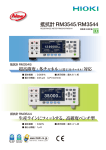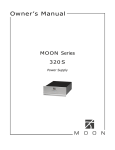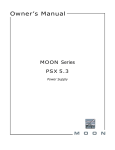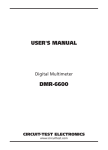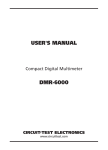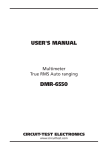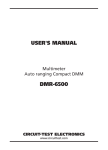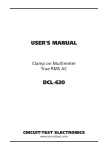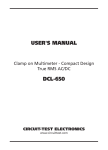Download Circuit-test DMR-3600 Owner`s manual
Transcript
OWNER’S MANUAL Digital Multimeter DMR-3600 CIRCUIT-TEST ELECTRONICS LTD A Division of R.P. Electronic Components Ltd. Burnaby, BC, Canada V5C 5Y1 www.circuittest.com INTRODUCTION Your Circuit-Test DMR-3600 Digital Multimeter incorporates the latest technology providing you with a feature packed instrument. With it you can measure a wide range of voltages, current, inductance, capacitance and resistance in the lab, shop, car and home. This meter has been designed for the Electrician, Technologist, Hobbyist and Educational Institutions. FEATURES Inductance - measure inductance from 1µH to 40H Capacitance - test capacitors up to 400µF Frequency - display frequency to 4MHz Continuity Buzzer - easily check for continuity. Diode Check - test diodes and other semiconductors for open & short circuits. HFE Test - displays DC current gain of Transistors Heavy Duty & Safe - designed to meet UL1244 & IEC1010 safety requirements. ! WARNING 1. Always start with the power off. Set the range switch to the correct setting before making any measurements. 2. Do not operate the unit unless the case is completely closed. 3. Disconnect test leads from equipment before removing the battery or fuse. 4. Never connect unit to AC or DC powered circuits when the range switch is set to resistance, diode check or continuity ranges. 5. To safeguard against electrical shock or damage to instrument, never connect it to more than 600V DC or 600V AC between input jacks and ground when measuring low energy circuits or 250VAC / 250VDC when measuring high energy circuits. 6. When using the test probes always keep your fingers behind the finger guards on the probes. Never touch the exposed probe tip. 7. Always inspect the instrument, test leads and other accessories for damage prior to use. 8. Disconnect the live/positive test lead prior before disconnecting the common/negative test lead. 9. Read this instruction manual carefully and completely before using. ! SAFETY PRECAUTIONS This meter is not recommended for high voltage industrial use; for example, do not use for measurements on 440VAC or 600VAC industrial power mains. The unit is intended for use with low energy circuits to 600VDC / 600VAC or high energy circuits to 250VAC / 250VDC only. – 2 – High voltage AC and DC circuits are dangerous. Use caution when working above 60VDC or 30VAC rms as these voltages pose a shock hazard. Always consider circuits to be energized. Never assume any equipment is deenergized. Lack of caution or poor safety practices can be very dangerous and/or lethal. SPECIAL FUNCTION MAX - When MAX is pressed, the last reading is held on the display until a higher reading is recorded. When using the MAX position on the Frequency range, the autoranging feature is disabled. SPECIFICATIONS General Display: Maximum Display: Ranging: Polarity: Measuring Rate: Input Impedance: Operation Temp.: Storage Temp.: Fuse: Power Source: Dimensions: Weight: 3 3/4 digit, 17mm (0.67") H LCD 3999 Manual ranging / Autoranging on Frequency Automatic, minus (-) sign indicates for negative polarity 2.5 times/second 10 MΩ (DCV/ACV) 0 to 45°C -15 to 50°C AGX 0.5A/250V & TUE10A/600V 9V Battery, NEDA 1604 or IEC 6F22 90(W) x 200(H) x 40(D)mm 400g (including battery) Ranges and Accuracy DC Voltage: 400mV-4-40-400-1000V ± (0.5% + 1) (Maximum measurement = 1000V) AC Voltage: 400mV-4-40-400V ± (1.5% + 4), 750V ± (2% + 4) (Maximum measurement = 750V RMS) (50 Hz - 500Hz) DC Current: 40mA-400mA ± (1.5% + 1), 10A ± (3% + 1) (Maximum voltage drop <325mV on all scales except 10A <700mV) AC Current: 40mA-400mA ± (2% + 4), 10A ± (3.5% + 4) (Maximum voltage drop <325mV on all scales except 10A <700mV) Resistance: 400Ω ± (1% + 3), 4K-40K-400K-4MΩ ± (0.8% + 2) 40MΩ ± (3% + 4), 4000MΩ ± ((5% + 10) +10 ) (Test voltages:400-4000MΩ 3.0V; 4K-40K-400K-4M-40MΩ 0.6V) – 3 – Capacitance: 4n-40n-400n-4µ-400µF ± (5% + 10), ±(8% + 10) (above 100µF) (Test voltage: 3V / Test frequency: 4n-40nF 1KHz; 400n-4µF 70Hz; 400µF 7Hz) Frequency: 4K-40K-400K-4000KHz ± (0.5% + 1) (Autoranging) (Sensitivity: 0.2Vrms minimum) Inductance: 4m-40m-400m-40H ± (5% + 10) 4H ± (5% + 20) (Test frequency: 4m-40mH 1KHz; 400mH-4H 70Hz; 40H 7Hz) Transistor HFE: 0-999 HFE Test base current: 10µA / Test voltage: 3.0 ± 0.4V Diode : Test current: 1.0 ± 0.6mA / Test voltage: <3.5V Logic: Logic High 2.8V ± 0.8V / Logic Low 0.8V ± 0.5V Frequency Response: 20MHz Detectable Pulse Width: 25nS Indication: 40msec beep at logic low Overload Protection Voltage: 500VDC / 350VAC - 400mV ranges 1000VDC / 750 VAC - 4-40-400-1000/750V ranges Current: 0.5A / 250 V Fuse for 40m-400mA ranges 10A / 600 V Fuse for 10A range (Maximum 60 seconds) Resistance: 500VDC / 500VAC Capacitance: 3VDC / 3VAC rms Frequency: 500VDC / 500VAC rms Inductance: 3VDC / 3VAC rms Logic: 500VDC / 500VAC rms Diode Test: 500VDC / 500VAC rms MEASUREMENTS Please take a few minutes to read the instructions and warnings prior to use. 1 DC VOLTAGE MEASUREMENT ! 1-1 1-2 1-3 WARNING: Maximum input is 1000V DC. Plug the red test lead into the VΩ jack and the black test lead into the COM jack. Set the DC/AC switch so that DC is displayed on the LCD. Set the range switch to the desired V voltage setting. If you are unsure of the voltage being measured, select the highest range and reduce until a satisfactory reading is obtained. – 4 – 1-4 1-5 1-6 Apply the test leads to the circuit to be measured. Ensure that the black lead is connected to the negative side of the circuit and the red lead to the positive. Read the displayed voltage. If the minus (-) sign appears the voltage is negative at the point being measured. 2 AC VOLTAGE MEASUREMENT ! 2-1 2-2 2-3 2-4 2-5 WARNING: Maximum input is 750V AC (RMS). Plug the red test lead into the VΩ jack and the black test lead into the COM jack. Set the DC/AC switch so that AC is displayed on the LCD. Set the range switch to the desired V voltage setting. If you are unsure of the voltage being measured, select the highest range and reduce until a satisfactory reading is obtained. Apply the test leads to the circuit to be measured. Read the displayed voltage. 3 DC CURRENT MEASUREMENT WARNING: Remove all power from circuit being tested when checking current. When using the 10A range, do not connect to the circuit for more than 60 seconds and wait 10 minutes between 10A measurements. 3-1 Plug the red test lead into the mA jack and the black test lead into the COM jack. If the current being measured is between 400mA and 10A insert the red test lead into the 10A jack. 3-2 Set the DC/AC switch so that DC is displayed on the LCD. 3-3 Set the range switch to the desired A current setting. If you are unsure of the current being measured, select the highest range and reduce until a satisfactory reading is obtained. 3-4 Remove power from the circuit that is to be measured. Open up the circuit and connect the black lead to the negative side and the red lead to the positive side of the circuit so that the test leads are in series with the load to be measured. 3-5 Apply power to the circuit. 3-6 Read the displayed current. 3-7 Remove power to the circuit being measured and disconnect test leads. NOTE: If changing range switch to or from the 10A position first disconnect power and test leads from the circuit being tested. Repeat the above steps using the correct input jack and range switch position. ! – 5 – 4 AC CURRENT MEASUREMENT WARNING: Remove all power from circuit being tested when checking current. When using the 10A range do not connect to the circuit for more than 60 seconds and wait 10 minutes between 10A measurements. 4-1 Plug the red test lead into the mA jack and the black test lead into the COM jack. If the current being measured is between 400mA and 10A insert the red test lead into the 10A jack. 4-2 Set the DC/AC switch so that AC is displayed on the LCD. 4-3 Set the range switch to the desired A current setting. If you are unsure of the value being measured, select the highest range and reduce until a satisfactory reading is obtained. 4-4 Remove power from the circuit that is to be measured. Open up the circuit and connect the black lead to one side and the red lead to other side of the circuit so that the test leads are in series with the load to be measured. 4-5 Apply power to the circuit. 4-6 Read the displayed current. 4-7 Remove power to the circuit being measured and disconnect test leads. NOTE: If changing range switch to or from the 10A position first disconnect power and test leads from the circuit being tested. Repeat the above steps using the correct input jack and range switch position. ! 5 RESISTANCE MEASUREMENT WARNING: Remove all power from circuit being tested when checking resistance. Discharge any charged capacitors. Never connect the probes to any voltage while the range switch is set to Ω. 5-1 Plug the red test lead into the VΩ jack and the black test lead into the COM jack. 5-2 Set the range switch to the desired Ω setting. If you are unsure of the resistance being measured, select the highest range and reduce until a satisfactory reading is obtained. 5-3 Attach the test leads to the circuit. 5-4 Read the displayed resistance. NOTE: 1. If you short the test leads together you will notice a small resistance value. This is due to the meter and test leads internal resistance. When measuring a small resistance subtract this value to obtain a more precise value. 2. When using the 400 Ω range the continuity buzzer will sound if the resistance being measured is less than 50 Ω. ! – 6 – 3. When using the 4000 MΩ range a fixed 20 count must be subtracted in order to obtain a true measurement. For example when measuring a resistance of 1200MΩ, the display will read 1220MΩ. 6 CONTINUITY TEST ! 6-1 6-2 6-3 6-4 WARNING: Remove all power from circuit being tested when checking continuity. Discharge any charged capacitors. Never connect the probes to any voltage while the range switch is set to 400 . Plug the red test lead into the VΩ jack and the black test lead into the COM jack. setting. Set the range switch to the 400 Attach the test leads to the circuit. The buzzer will sound when the circuit has less than 50 Ω resistance and the measured resistance value will be displayed. 7 DIODE TEST ! 7-1 7-2 7-3 7-4 7-5 WARNING: Remove all power from circuit being tested when using the diode check. Discharge any charged capacitors. Never connect the probes to any voltage while the range switch is set to . Plug the red test lead into the VΩ jack and the black test lead into the COM jack. Set the range switch to the setting. Connect the probes to the device you want to test. Note the meter reading. Reverse the probes and note this reading. If both values are between 2.8V and 3.2V the device is open. If both values are very small the device is shorted. If one reading is between 2.8V and 3.2V and the other is between 0.5 and 0.7V then the device is good. 8 TRANSISTOR HFE MEASUREMENT WARNING: Remove all power from circuit being tested when using the HFE ranges. Discharge any charged capacitors. Never connect the probes to any voltage while the range switch is set to HFE. 8-1 Set the range switch to either the NPN or PNP position. 8-2 Insert the leads of the transistor into the correct positions of the transistor socket. 8-3 Read the displayed transistor HFE. NOTE: The HFE reading is limited to the test current of the multimeter circuit (10µA/3.0V). This may be different than the published transistor data but will provide information as to whether the transistor is functional. ! – 7 – 9 FREQUENCY MEASUREMENT WARNING: Maximum input is 500 V. 9-1 Plug the red test lead into the VΩ jack and the black test lead into the COM jack. 9-2 Set the range switch to the KHz setting. 9-3 Connect the probes to the point of measurement. 9-4 Read the displayed frequency. NOTE: When using the Frequency measurement position the autoranging feature can be disabled by pressing the MAX switch. ! 10 CAPACITANCE MEASUREMENT WARNING: Fully discharge capacitors by shorting the capacitor leads together before testing. 10-1 Set the range switch to the desired F capacitance setting. If you are unsure of the value being measured, select the highest range and reduce until a satisfactory reading is obtained. 10-2 Insert the capacitor leads into the Cx / Lx test sockets. Ensure that the capacitor leads are inserted into opposing sockets. 10-3 Read the displayed capacitor value. ! 11 INDUCTANCE MEASUREMENT 11-1 Set the range switch to the desired H Inductance setting. If you are unsure of the value being measured, select the highest range and reduce until a satisfactory reading is obtained. 11-2 Insert the inductor leads into the Cx / Lx test sockets. Ensure that the leads are inserted into opposing sockets. 11-3 Read the displayed inductance value. 12 LOGIC TEST 12-1 Plug the red test lead into the VΩ jack and the black test lead into the COM jack. 12-2 Set the range switch to the setting. 12-3 Connect the red test lead to the point to be tested and the black test lead to the common buss of the logic circuit. 12-4 Apply power to the circuit. 12-5 If the circuit is in the High Logic state, the high indicator will appear. If it is in the Low Logic state the low indicator will appear. If the point of measurement is toggling high and low then both indicators will be displayed. – 8 – 13 BATTERY REPLACEMENT ! 13-1 13-2 13-3 13-4 13-5 WARNING: Disconnect both test leads from any equipment before removing back cover. Do not use meter with case opened. The “ ” will appear on the display when the battery requires replacing. Disconnect both test leads and turn off the power. Remove the screws in the rear cover of the case and remove the cover. Unsnap the battery from the connector and replace with a new 9V battery. Replace the cover and cover screws. 14 FUSE REPLACEMENT ! 14-1 14-2 14-3 14-4 WARNING: Disconnect both test leads from any equipment before removing back cover. Do not use the meter with the case opened. Disconnect both test leads and turn off the power. Remove the screws in the rear cover of the case and remove the cover. Replace the blown fuse with a fuse of the proper rating AGX 0.5A/250V or TUE 10A/600V. Do not use a fuse which has a higher rated value than specified or try to bypass the fuses. Replace the cover and cover screws. – 9 – ACCESSORIES Test Leads (set): TL-125 Holster (optional): CS-3600H Fuses: AGX 0.5A/250V & TUE 10A/600V LIMITED WARRANTY Circuit-Test Electronics warrants to the original purchaser that this product be free of defect in material or workmanship for a period of 2 years from the date of purchase. If this product requires warranty service, return the unit (freight prepaid), together with your dated proof of purchase and explanation of the defect to: In Canada: Circuit-Test Electronics (A Division of R.P. Electronic Components Ltd.) 2060 Rosser Ave Burnaby, BC, V5C 5Y1 Any product which has been subjected to misuse or accidental damage is excluded from the warranty. Except as stated above, Circuit-Test Electronics makes no promises or warranties either expressed or implied including warranties of merchantability or the fitness for any particular purpose. This warranty gives you specific legal rights and you may have other rights which vary under the laws of the various countries, states or provinces in which Circuit-Test Electronics operates. – 10 –










